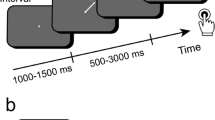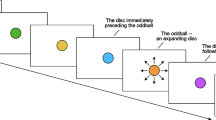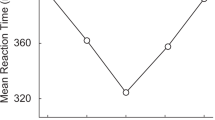Abstract
During brief, dangerous events, such as car accidents and robberies, many people report that events seem to pass in slow motion, as if time had slowed down. We have measured a similar, although less dramatic, effect in response to unexpected, nonthreatening events. We attribute the subjective expansion of time to the engagement of attention and its influence on the amount of perceptual information processed. We term the effecttime’s subjective expansion (TSE) and examine here the objective temporal dynamics of these distortions. When a series of stimuli are shown in succession, the lowprobabilityoddball stimulus in the series tends to last subjectively longer than the high-probability stimulus even when they last the same objective duration. In particular, (1) there is a latency of at least 120 msec between stimulus onset and the onset of TSE, which may be preceded by subjective temporal contraction; (2) there is a peak in TSE at which subjective time is particularly distorted at a latency of 225 msec after stimulus onset; and (3) the temporal dynamics of TSE are approximately the same in the visual and the auditory domains. Two control experiments (in which the methods of magnitude estimation and stimulus reproduction were used) replicated the temporal dynamics of TSE revealed by the method of constant stimuli, although the initial peak was not apparent with these methods. In addition, a third, control experiment (in which the method of single stimuli was used) showed that TSE in the visual domain can occur because of semantic novelty, rather than image novelty per se. Overall, the results support the view that attentional orienting underlies distortions in perceived duration.
Article PDF
Similar content being viewed by others
Avoid common mistakes on your manuscript.
References
Allan, L. G. (1977). The time-order error in judgments of duration.Canadian Journal of Psychology,31, 24–31.
Allan, L. G. (1979). The perception of time.Perception & Psychophysics,26, 340–354.
Allan, L. G. (1984). Contingent aftereffects in duration judgments. In J. Gibbon & L. G. Allan (Eds.),Timing and time perception (Annals of the New York Academy of Sciences, Vol. 423, pp. 116–130). New York: New York Academy of Sciences.
Allan, L. G., &Gibbon, J. (1994). A new temporal illusion or the TOE once again?Perception & Psychophysics,55, 227–229.
Avant, L. L., Lyman, P. J., &Antes, J. R. (1975). Effects of stimulus familiarity on judged visual duration.Perception & Psychophysics,17, 253–262.
Baylis, G., &Driver, J. (1995). One-sided edge assignment in vision: 1. Figure-ground segmentation and attention to objects.Current Directions in Psychological Science,4, 140–146.
Brown, S. W. (1985). Time perception and attention: The effects of prospective versus retrospective paradigms and task demands on perceived duration.Perception & Psychophysics,38, 115–124.
Brown, S. W. (1995). Time, change, and motion: The effects of stimulus movement on temporal perception.Perception & Psychophysics,57, 105–116.
Cantor, N. E., &Thomas, E. A. (1977). Control of attention in the processing of temporal and spatial information in complex visual patterns.Journal of Experimental Psychology: Human Perception & Performance,3, 243–250.
Creelman, C. D. (1962). Human discrimination of auditory stimuli.Journal of the Acoustical Society of America,34, 582–593.
Fechner, G. T. (1860).Elemente der Psychophysik. Leipzig: Breitkopf & Härtel.
Fechner, G. T. (1882).Revision der Hauptpunkte der Psychophysik. Leipzig: Breitkopf & Härtel.
Festinger, L., Coren, S., &Rivers, G. (1970). The effect of attention on brightness contrast and assimilation.American Journal of Psychology,2, 126–150.
Fraisse, P. (1963).The psychology of time. New York: Harper & Row.
Fraisse, P. (1984). Perception and estimation of time.Annual Review of Psychology,35, 1–36.
Frankenhauser, M. (1959).Estimation of time. Uppsala, Sweden: Almqvist & Wiksell.
Garcia-Larrea, L., Lukaszewicz, A.-C., &Mauguiere, F. (1992). Revisiting the oddball paradigm: Non-target vs. neutral stimuli and the evaluation of ERP attentional effects.Neuropsychologia,30, 723–741.
Grondin, S., &Macar, F. (1992). Dividing attention between temporal and nontemporal tasks: A performance operating characteristic— POC—analysis. In F. Macar, V. Pouthas, & W. Friedman (Eds.),Time, action and cognition: Towards bridging the gap (pp. 119–128). Dordrecht: Kluwer.
He, Z. J., &Nakayama, K. (1992). Surfaces versus features in visual search.Nature,359, 231–233.
Hellström, Å. (1977). Time errors are perceptual.Psychological Research,39, 345–388.
Hellström, Å. (1979). Time errors and differential sensation weighting.Journal of Experimental Psychology: Human Perception & Performance,5, 460–477.
Hellström, Å. (1985). The time-order error and its relatives: Mirrors of cognitive processes in comparing.Psychological Bulletin,97, 35–61.
Helson, H. (1947). Adaptation level as frame of reference for prediction of psychophysical data.American Journal of Psychology,60, 1–29.
Helson, H. (1964).Adaptation-level theory. New York: Harper & Row.
Hicks, R. E., &Brundige, R. M. (1974). Judgments of temporal duration while processing verbal and physiognomic stimuli.Acta Psychologica,38, 447–453.
Hicks, R. E., Miller, G. W., Gaes, G., &Bierman, K. (1977). Concurrent processing demands and the experience of time-in-passing.American Journal of Psychology,90, 431–446.
Hicks, R. E., Miller, G. W., &Kinsbourne, M. (1976). Prospective and retrospective judgments of time as a function of amount of information processed.American Journal of Psychology,89, 719–730.
Hikosaka, O., Miyauchi, S., &Shimojo, S. (1993). Focal visual attention produces illusory temporal order and motion sensation.Vision Research,33, 1219–1240.
Hollingworth, H. L. (1910). The central tendency of judgment.Journal of Philosophy, Psychology, & Scientific Methods,7, 461–468.
Hülser, C. (1924). Zeitauffassung und Zeitschätzung verschieden ausgefüllter Intervalle unter besonderer Berücksichtigung der Aufmerksamkeitsablenkung.Archiv der Gesamten Psychologie,49, 363–378.
Irwin, D. E., Colcombe, A. M., Kramer, A. F., &Hahn, S. (2000). Attentional and oculomotor capture by onset, luminance and color singletons.Vision Research,40, 1443–1458.
James, W. (1950).The principles of psychology. New York: Dover. (Original work published 1890)
Jamieson, D. G., &Petrusic, W. M. (1975). Pairing effects and time-order errors in duration discrimination.Perception & Psychophysics,18, 107–113.
Jonides, J., &Yantis, S. (1988). Uniqueness of abrupt visual onset in capturing attention.Perception & Psychophysics,43, 346–354.
Kahneman, D. (1973).Attention and effort. Englewood Cliffs, NJ: Prentice-Hall.
Katz, D. (1906). Experimentelle Beiträge zur Psychologie des Vergleichs im Gebiete des Zeitsinns [Experimental contributions to the psychology of our sense of time].Zeitschrift für Psychologie, Physiologie der Sinnesorgane,42, 302–340.
Leuba, A. (1892). A new instrument for Weber’s law; with indications of a law of sense memory.American Journal of Psychology,5, 370–384.
Macar, F., Grondin, S., &Casini, L. (1994). Controlled attention sharing influences time estimation.Memory & Cognition,22, 673–686.
Mackeben, M., &Nakayama, K. (1993). Express attentional shifts.Vision Research,33, 85–90.
Mattes, S., &Ulrich, R. (1998). Directed attention prolongs the perceived duration of a brief stimulus.Perception & Psychophysics,60, 1305–1317.
McKee, S. P., Klein, S. A., &Teller, D. Y. (1985). Statistical properties of forced-choice psychometric functions: Implications of probit analysis.Perception & Psychophysics,37, 286–298.
Michon, J. A. (1978). The making of the present: A tutorial review. In J. Requin (Ed.),Attention and performance VII (pp. 89–109). Hillsdale, NJ: Erlbaum.
Nakajima, Y., ten Hoopen, G., Hilkhuysen, G., &Sasaki, T. (1992). Time-shrinking: A discontinuity in the perception of auditory temporal patterns.Perception & Psychophysics,51, 504–507.
Nakajima, Y., ten Hoopen, G., &van der Wilk, R. G. H. (1991). A new illusion of time perception.Music Perception,8, 431–448.
Nakayama, K., &Mackeben, M. (1989). Sustained and transient components of focal visual attention.Vision Research,29, 1631–1647.
Ornstein, R. E. (1969).On the experience of time. Baltimore: Penguin.
Petrusic, W. M. (1984). Explicit counting and time-order errors in duration discrimination. In J. Gibbon & L. Allan (Eds.),Timing and time perception (Annals of the New York Academy of Sciences, Vol. 423, pp. 630–633). New York: New York Academy of Sciences.
Polich, J. (1986). Attention, probability, and task demands as determinants of P300 latency from auditory stimuli.Electroencephalography & Clinical Neurophysiology,63, 251–259.
Potts, G. F., Liotti, M., Tucker, D. M., &Posner, M. I. (1996). Frontal and inferior temporal cortical activity in visual target detection: Evidence from high spatially sampled event-related potentials.Brain Topography,9, 3–14.
Pratt, C. C. (1933). Time-errors in the method of single stimuli.Journal of Experimental Psychology,16, 798–814.
Predebon, J. (1996). The relationship between the number of presented stimuli and prospective duration estimates: The effect of concurrent task activity.Psychonomic Bulletin & Review,3, 376–379.
Quasebarth, K. (1924). Zeitschätzung und Zeitauffassung optisch und akustisch ausgefüllter Intervalle.Archiv der Gesamten Psychologie,49, 379–432.
Remington, R. W., Johnston, J. C., &Yantis, S. (1992). Involuntary attentional capture by abrupt onsets.Perception & Psychophysics,51, 279–290.
Rensink, R. A., &Enns, J. T. (1995). Preemption effects in visual search: Evidence for low-level grouping.Psychological Review,102, 101–130.
Rose, D., &Summers, J. (1995). Duration illusions in a train of visual stimuli.Perception,24, 1177–1187.
Schab, F. R., &Crowder, R. G. (1988). The role of succession in temporal cognition: Is the time-order error a recency effect of memory?Perception & Psychophysics,44, 233–242.
Schiffman, H. R., &Bobko, D. J. (1974). Effects of stimulus complexity on the perception of brief temporal intervals.Journal of Experimental Psychology,103, 156–159.
Shiu, L.-P., &Pashler, H. (1995). Spatial attention and vernier acuity.Vision Research,35, 337–343.
Stelmach, L. B., Herdman, C. M., &McNeil, K. R. (1994). Attentional modulation of visual processes in motion perception.Journal of Experimental Psychology: Human Perception & Performance,20, 108–121.
Thomas, E. A. C., &Brown, T. I., Jr. (1974). Time perception and the filled-duration illusion.Perception & Psychophysics,16, 449–458.
Thomas, E. A. C., &Cantor, N. E. (1978). Interdependence between the processing of temporal and non-temporal information. In J. Requin (Ed.),Attention and performance VII (pp. 43–62). Hillsdale, NJ: Erlbaum.
Thomas, E. A. C., &Weaver, W. B. (1975). Cognitive processing and time perception.Perception & Psychophysics,17, 363–367.
Treisman, M. (1963). Temporal discrimination and the indifference interval: Implications for a model of the “internal clock”.Psychological Monographs,77, 1–31.
Tse, P. U., Sheinberg, D. L., &Logothetis, N. K. (2003). Attentional enhancement opposite a peripheral flash revealed using change blindness.Psychological Science,14, 91–99.
Underwood, G., &Swain, R. A. (1973). Selectivity of attention and the perception of duration.Perception,2, 101–105.
Vierordt, K. von (1868).Der Zeitsinn nach Versuchen. Tübingen: Laupp.
Weinberg, L. (1991–1995).Poser [Computer software]. Fractal Design Corp.
Woodrow, H. (1930). The reproduction of temporal intervals.Journal of Experimental Psychology,13, 473–499.
Woodrow, H. (1951). Time perception. In S. S. Stevens (Ed.),Handbook of experimental psychology (pp. 1224–1236). New York: Wiley.
Yantis, S., &Egeth, H. E. (1999). On the distinction between visual salience and stimulus-driven attentional capture.Journal of Experimental Psychology: Human Perception & Performance,25, 661–676.
Yantis, S., &Jonides, J. (1990). Abrupt visual onsets and selective attention: Voluntary versus automatic allocation.Journal of Experimental Psychology: Human Perception & Performance,16, 121–134.
Zakay, D. (1993). Time estimation methods: Do they influence prospective duration estimates?Perception,22, 91–101.
Zakay, D., &Tsal, Y. (1989). Awareness of attention allocation and time estimation accuracy.Bulletin of the Psychonomic Society,27, 209–210.
Author information
Authors and Affiliations
Corresponding author
Additional information
This research was supported by McDonnell-Pew Grant 98-49CNS and NIH Grant R03 MH0609660-01 to P.U.T., by the Max Planck Society, AASERT Grant F49620-94-1-0376 to P.C., and by NSERC Grant 015593 to J.R.
Note—This article was accepted by the previous editorial team, headed by Neil Macmillan.
Rights and permissions
About this article
Cite this article
Tse, P.U., Intriligator, J., Rivest, J. et al. Attention and the subjective expansion of time. Perception & Psychophysics 66, 1171–1189 (2004). https://doi.org/10.3758/BF03196844
Received:
Accepted:
Issue Date:
DOI: https://doi.org/10.3758/BF03196844





